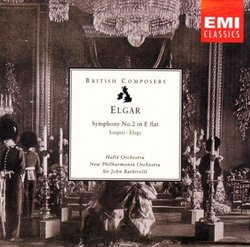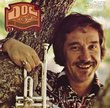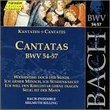Elgar personalized, passionate and devotional
Larry VanDeSande | Mason, Michigan United States | 02/17/2007
(5 out of 5 stars)
"Sir John Barbirolli began his conducting career in 1927, being called in as an emergency replacement to conduct this symphony, Elgar's Symphony No. 2. For that reason and others, the opus was always special to Barbirolli and he conducted it many times over his career. The notes to this issue suggest Barbirolli's 43-year contractual agreement with EMI began as an outcome of that first performance.
Anyone who knows Sir John's work knows he is deliberate on the podium. Just about every recording he ever made, including that famous "Eroica" from 1967 that Brits still cling to, is constructed of deliberate tempi that allow the listener to hear every nuance of the score and scoring.
And so it is here in this recording of his beloved Elgar 2nd Symphony. His pace is slower than most other conductors, something that, ironically, endeared him to Americans and chilled him with the Penguin Guide authors, who have complained about Barbirolli tampering with tempi in this recording since its arrival.
Americans, on the other hand, seem to love his work. As American Record Guide stated in its most recent overview of English symphonies, "If you like slow tempos, it goes to the top of the list." It should be noted ARG
graded the Barbirolli stereo recording (an earlier mono version from 1954 is still available through EMI) at the top of its list of recommended recordings.
The stately tempi are apparent from the opening bars of that magisterial first subject in the opening movement, where Barbirolli leisurely, but dramatically, brings the Halle players into your living room. The conductor likes to speed up and slow down the action occasionally, which is what the Penguin Guide authors complain about. I find this adds warmth, rubato and charge to the music, which can be manic and italicized under the baton of a lesser conductor like Barenboim.
I think the larghetto is clearly the heart of Barbirolli's performance. Listen for the brass chorale with descending string motif in the middle of the movement, followed soon by wind counterpoint against brass and strings that comprise the emotional center. Here Barbirolli caress Elgar's notes, briniging to life all the feelings inherent in the score and, perhaps, the composer's current vision.
While Elgar denied it, many continue to believe the symphony represents anticipated doom from the Great War that was expected to devastate the continent. But just as Ralph Vaughan Williams denied any war link to his violent Symphony No. 4 -- and a listener is advised to accept that -- you should accept the composer's notion that this opus represents a less complex but more emotional musical landscape than his popular Symphony No. 1.
Barbirolli is careful to project the composer's mixed emotions; note how he moves almost seemelessly out of the adagio and into the rondo before going headlong into its jolly and more rapid rhythms. Sir John is clearly a devotee of the music and his individual ideas about it form his singular drama and passion that's always sympathetic to the world inside Elgar's head and heart.
While a poor performance led by the conductor may have resulted in audiences sitting like "stuck pigs" when this music was first played, no audience member would sit still for long while this performance was ongoing. This recording says a lot about both Elgar's and Barbirolli's English roots and spirit and the way they merged to create a very special rumination through the symphony.
The Halle Orchestra plays exceptionally here, as does the New Philharmonia in the shorter pieces, and the recording is pretty good for being more than 40 years old. An occasional spotlighted instrument does nothing to diminish the recording or the impact of the performance. This will probably always be considered de rigeur in this music for people that accept Sir John's rigors as labor of British love."
Superlative Elgar From Barbirolli
Jeffrey Lipscomb | Sacramento, CA United States | 05/08/2005
(5 out of 5 stars)
"Elgar's 2nd Symphony (1910-11) is, to my ears, not only the composer's finest work, but arguably the greatest of ALL English symphonies. This very expressive, deeply thoughtful, and well-recorded performance was done by Barbirolli in the mid-1960's with his beloved Halle Orchestra. Barbirolli opts for fairly broad tempos that allow many details to stand out more fully than the norm (e.g., I have never heard the harp part so clearly before). The result is one of the most majestic and moving performances on disc.
This is my favorite stereo Elgar 2nd. I prefer it to Barbirolli's earlier mono recording and to all but one of Boult's 5 recordings. The three Elgar 2nds that would go with me to the proverbial "desert island" are this Barbirolli, the 1957 Boult/London Philharmonic (in early stereo on an out of print Nixa CD that needs re-issue), and the composer's 1927 recording with the London Symphony (in surprisingly good sound, best heard on a 5-LP box set from EMI called "Images of Elgar," which includes a fascinating rehearsal segment where Elgar explains some of the rhythmic niceties of the 3rd movement).
Where Boult scores over Barbirolli is in rhythmic precision (especially in the Larghetto), his seamless tempo transitions in the first movement, and the extraordinary pounding ostinato of the Rondo's episode where Elgar's fantasy of being buried "a yard beneath the street" recalls Tennyson's words "The hoofs of the horses beat, Beat into my scalp and brain." Boult is a bit closer to Elgar on these points, although the composer is consistently the fastest of the three conductors (no doubt motivated by the dictates of 4 minute 78 rpm sides). This was Boult at his very finest - in fact, it's my single favorite performance by him of ANYTHING outside of his near-definitive Vaughan Williams recordings (see my review of his stereo EMI set). However, neither Elgar nor Boult is as compellingly moving as Barbirolli in the climax of the Adagio (where the conductor can be heard urging on the Halle's strings), or in the 4th movement, where Barbirolli best captures the music's elegaic sense of the sun setting on both the Edwardian era and the British Empire.
Barbirolli's wonderful performance has my highest recommendation for a stereo Elgar 2nd, along with the currently unavailable 1957 Boult (Nixa). But be sure to give the composer's own version a try as well, if you can find it.
Jeff Lipscomb
"
An Outstanding Elgar CD
Francis B. Shaffer | Newport, RI USA | 12/02/2000
(5 out of 5 stars)
"Definitive performances of music that exemplifies the best of Elgar. The symphony was written to express Elgar's and the nation's grief on the death of Edward, Queen Victoria's successor; no monarch could ask for a better memorial. The two short pieces, "Sospiri" and "Elegy" fit well emotionally with the symphony."


 Track Listings (6) - Disc #1
Track Listings (6) - Disc #1

